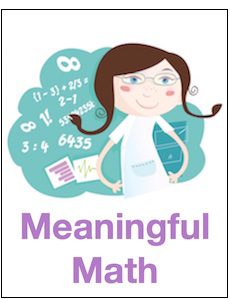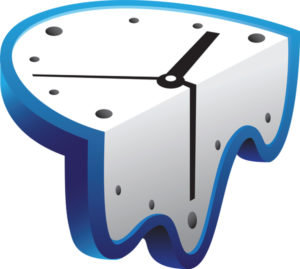Slowing Math Down for Stickier 2020 Learning
A MiddleWeb Blog

For the students learning virtually I post all my lessons on Canvas as well as posting a video of the class each day.
Teaching face to face and virtually is presenting some challenges. I’m finding that students who are learning virtually are really struggling to keep pace with the face-to-face class.
So I have had to make some adjustments to my pacing. I have had to reduce the amount of assignments I give (virtually and face to face) and purposely slow things down.
Fortunately, in our state (Alabama) we are encouraged to focus on critical standards, which is a subset of the standards we usually teach. I feel like I have been given permission to slow down, and I don’t worry as much about “covering” all the material.
By slowing down, I don’t mean that we are wasting class time or we aren’t doing anything. I mean we are spending more time doing the same things, even if we are doing them in different ways.
Honestly, I was resistant at first. I wasn’t sure that changing my pacing would help, but eventually I started to notice the benefits of slowing down.
Benefits of a Slower Pace

✻ Slowing down helps prevent virtual students from becoming overwhelmed.
✻ Slowing down has reduced anxiety and increased confidence in my face-to-face students.
✻ It’s helped me realize and really understand how much students struggle with the “little” things, like using the calculator, basic calculations with signed numbers, and how to use formulas. These are things that I am usually moving too fast to notice.
✻ I enjoy teaching more! I’m less anxious about how much I need to cover.
✻ Slowing down has allowed me the time to try out new activities.
Activities that are Working for Me Right Now

Both of these activities were very well received by my students. In fact, when we did Polygraph: Parabolas a number of students asked to play again when they came to class the next day, and students continued to play after class ended – that never happens. There have been many years that I wanted to incorporate more Desmos activities, but I didn’t have the time. (Desmos works well for both virtual and face to face students.)
2.) Old school game – BINGO! Understandably, when my students returned this year, they were a little bit rusty. They needed practice with multiplication facts, perfect squares, and other foundational concepts. I tried to think of a way that would help them practice but was not some kind of test or quiz. I decided to see if they would be interested in an old school game of Bingo. Surprisingly, they responded really positively.
They make their own Bingo cards on regular note paper, just a 5×5 grid. I write on the board what I want them to fill in the grid (although where they place it is up to them). I will give them list of products (56, for example), some perfect squares, the value of pi, etc.
Then, taking on the role of the caller, I might call out 7×8 and they mark out 56 on their bingo card, or if I called out 23 they’d mark out 8 on their paper. We play a couple of rounds (without a calculator), and it’s easy way to reinforce some basic facts without having to do a timed test, which they routinely tell me scarred them for life in math. (Bingo is more suited for face to face.)
Slowing Down Now and in the Future
I have always had to move at a certain pace to be able to teach all the standards I am responsible for teaching. It’s been nice to be able to move slower and allow students the time they need.
More and more I’m realizing that it has to have been frustrating for students when we moved on to a new topic just when they were starting to understand the current topic. I think that is part of the reason why students can’t remember what they did in math class from year to year.
Initially I resented having to change my pacing to accommodate a slower pace. I changed my mind after seeing how much better it was for my students. I am already thinking how I can manage to give students the time they need when we go back to a more traditional school year.
Has anyone else had this experience? Have you felt like your students benefited from a slow down? Have we been asking for too much too fast in the past? Please let me know in the comments!































I am a 7th Grade Math teacher, the middle of the Middle. In my school, we take a multi-year approach to skill building – Intro / Practice / Master. Some skills take multiple years to work through those 3 stages, others we introduce and spiral throughout the year, with the intent of achieving some degree of mastery before they move on to the next grade.
I am concerned that this move in mathematics to ‘drop back’, because COVID or something, is going to have long-term negative consequences. We used to teach grit and perseverance and productive struggle, now we look for an hint of anxiety and cater to it. Granted, some students aren’t going to wind up in the higher math classes like Calculus A or B, but if we don’t start preparing them, even in Middle School, by teaching the full curriculum (not just a scaled back ‘essentials’), most will not be ready to even tackle some of Algebra 2 or PreCal.
When I began my teaching career 18 years ago, right as SpEd students were being mainstreamed, we were told by our administrators and educational leaders that if we set a standard, our students will rise to meet it. It may be a multi-year struggle for some, but they will eventually be on-grade and successful. I feel like we have forgotten those lessons.
Thank you for your comment! Your concerns are valid, they are exactly why I struggled with adjusting my pacing. However, the reality is that I don’t have as much time with my students as I have had in the past, and I would rather teach fewer concepts more rigorously than teacher more concepts superficially.
To address your concern about catering to students’ anxiety, I only partly slowed down to reduce anxiety among my students, the other part was to reduce my own anxiety. I don’t feel as rushed and I don’t constantly “feel behind”. I don’t think what I am doing is a perfect solution, right now I don’t think there are any perfect solutions, but this seems to be working for my students.